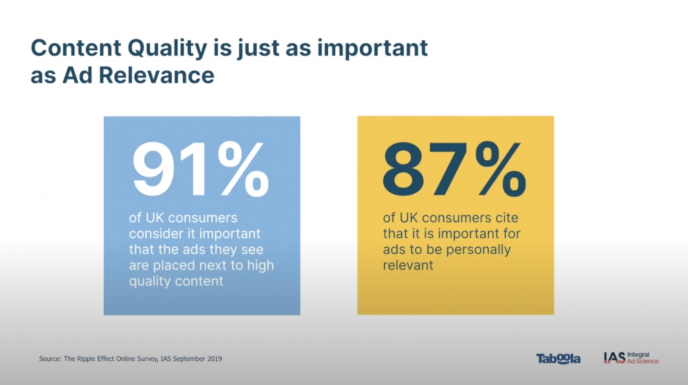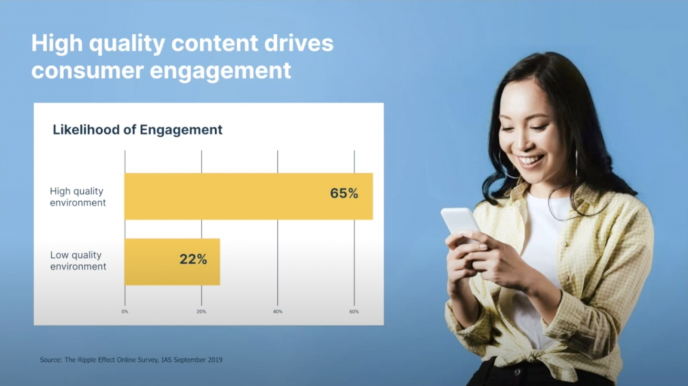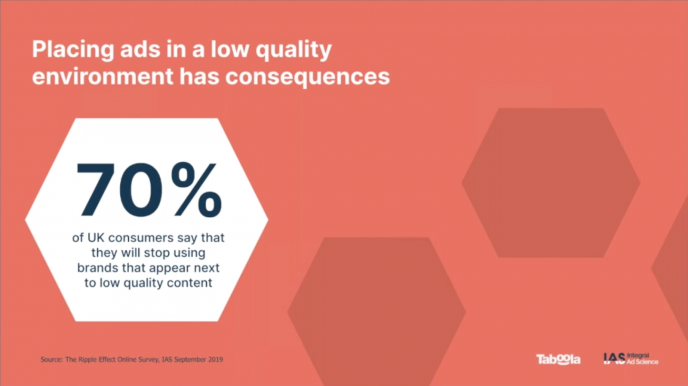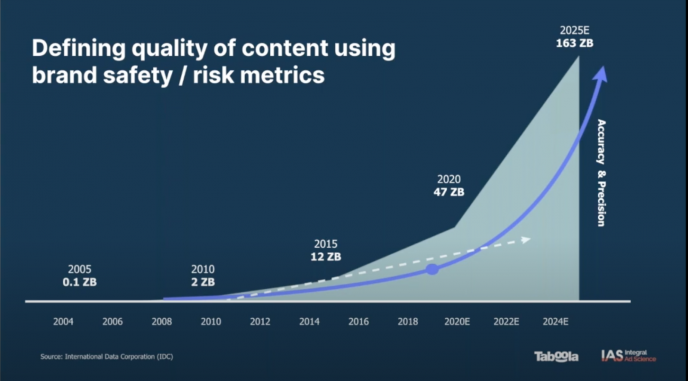The turbulence 2020 brought opened up new conversations about brand safety, digital privacy, and risk management. This includes topics like contextual targeting, the aftereffects of COVID-19, and a boom in TV and streaming.
We tackled these topics and more in partnership with IAS.
Stacey Delaney (UK Country Manager at Taboola) and speakers Patrick Zinga (Digital Strategy & Planning Lead EMEA at StarCom), Rachel Waine (Digital Director EMEA at MediaCom), Rebecca Degiorgio (Paid Search Director at iCrossing,) and Paul Astbury (Business Development Director EMEA, Integral Ad Science) discuss the evolution of brand safety and a Q&A session with industry experts.

Throughout the webinar, speakers also discussed insights from IAS’s recent report — IAS Ripple Effect Online Survey, which included responses from UK consumers.
Brands are Responsible for their Own Brand SAfety
Taboola kicks things off with an overview of the evolution from brand safety to brand suitability. Brand safety has always been at the forefront of conversations between brands and agencies, and that’s still the case:
“Brand safety has always been at the forefront. Negative sentiment blocking has become more important than ever, but it has always been a priority,” Waine said.
Degiorgio agreed, and Astbury weighed in with specifics they tackle during the onboarding process:
“When onboarding a new client, we need to understand what brand safety means to each client. We evaluate which tactics, strategies, and partners fit the brand’s needs. Agencies have had to show how agile and responsive they can be.” – Zinga said.
Ultimately, when it comes to brand safety and suitability, it’s clients that drive the conversation, especially those who are up against a bit more red tape.
“Clients in highly regulated industries are more concerned with brand suitability and safety. Agencies must understand their clients and industries to discuss what is appropriate in their ad environment.” – Degiorgio said
This is in line with IAS’s findings — they asked respondents who they thought was responsible for brand safety, and brands/agencies were the top choice. Here’s how the number shook out:
- Brands / Agencies (33%)
- Publishers (31%)
- Verification Partners (28%)
- SSPs (5%)
- DSPs (3%)
“It’s up to the client to define their level of risk and what is appropriate for their brand. Every brand and every vertical will have unique criteria that need to be addressed on a case by case basis,” Waine said.
Surrounding Content Must Be High Quality
Many marketers worry that they have to choose between maximizing reach and ensuring that their ads are only displayed in brand-safe environments.
To achieve the right balance of scale vs safety, while also hitting clients’ KPIs, and retaining brand safety, content has to be of the highest quality.
“It’s a matter of quality over content. You have to maximize reach over quality content to get engagement and attention. It’s important to understand a brand’s risk tolerance for suitability versus their desire to scale,” Waine said.
In IAS’s recent survey, 91% stress the importance of the ad environment and the quality of content surrounding it compared to 87% who stress the importance of ads that are personally relevant to them.

“You want to get the most cost-efficient CPA without limiting your reach. If you add multiple lines of targeting, you are limiting your reach, so you have to balance hitting campaign objectives while maintaining brand suitability. If you want to reach more people at scale with quality content, you should expect to pay a higher premium,” Zinga said.
This puts premium publishers at an advantage, especially since 65% of consumers stated a likelihood of engagement with ads in a high-quality environment versus only 22% who would be likely to engage with ads in a low-quality environment.

When placed on a low-quality site categorized as high risk, consumer perception is affected.
88% of consumers found ads annoying, 55% felt less favorable toward the brand in the ad, and 70% would actually stop doing business with the brand.

“The most important thing is an honest conversation with your partners about brand suitability and controls. The technology and education on brand suitability vary across different markets. Some advertisers may have to accept that their consumers also consume low-quality content, and therefore they must advertise in those environments to reach them,” Zinga said.
Controlling ad placement can be challenging. Worldwide data creation is accelerating, has led to an increase in ad placement opportunities but led to challenges that advertising technology must adapt to.

Overly cautious brands with long keyword blocking lists have damaged relationships with publishing partners in a number of ways.
- Less monetized inventory.
- Missed opportunities to connect with the right audience by appearing next to contextually relevant content.
- Wasted ad spends by appearing on pages unrelated to the brand.
Publishers play a key role in the digital advertising ecosystem. Context is the new battleground for marketers. Effective marketers are able to control the environment while continuing to run at scale, driving business outcomes.
“There has to be a balancing act between what’s possible in brand safety without limiting too much. Too much blocking limits performance,” Waine said
The Next Evolution: Brand Suitability Controls
With the shift to suitability, it’s key that brands can access suitability controls to exclude unsuitable content. Technology that classifies content at scale can read content like a human.
One of the issues that have come to light around brand safety in 2020 is keyword blocking and in some cases overblocking. To make sure that agency’s are blocking the right keywords to ensure brand safety for their clients without compromising results, they turn to context.
“Keyword blocking is a blunt tool, which can inadvertently block a large amount of news content. Rather than blocking catchall phrases, block the negative associations around news, stories, and articles. Brands must take advantage of contextually relevant content,” Waine said.
The future is a focus on suitability and sentiment technology, to get the industry closer to the true meaning of quality at scale:
“The use of keywords have their place, but the recommendation to agencies is to focus more on brand suitability and sentiment technology. Not all content around a particular topic is actually negative. You want to be able to run at scale and engage with consumers around positive content,” Astbury said.
“If you’re looking after the likes of Durex, you can’t keyword block ‘sex’ because that is what your brand does. Page-level analysis of suitability and sentiment is key. AI understands the English language better than people. Keyword blocking is becoming an archaic approach,” Zinga said.
While brand suitability is the priority, risk mitigation is also top of the list in 2021, according to IAS’s survey:
- 48% consider brand risk mitigation a high priority
- 31% a very high priority
- 14% a medium priority
- 5% a low priority
- 2% a very low priority
To keep on top of mitigation, it’s all about transparency and frequent reporting:
“You just regularly evaluate which publishers perform best and are most suitable for the brand,” Waine said.
“In addition, it comes down to transparent and actionable reporting and analysis for clients,” Degiorgio said.
Key Takeaways
This year is all about suitability, quality and context. A few key takeaway from this event:
- Context is critical. Brands need ads to appear in suitable environments while also aligning with privacy regulations.
- Consumers are receptive to conceptual targeting. More consumers prefer contextually relevant environments over the use of personal data.
- Brands can refine suitability by removing keyword blocking lists.
- Upgrade to controls that analyze the context, semantic, sentiment, and emotion of content.
IAS technology gets to the true meaning of the content and the emotions conveyed by the author. This ensures that your ad is placed alongside content that will connect with your consumers. This allows brands to move away from binary keyword blocking and advertise at scale in brand-suitable environments.
Now, using our integration with IAS’s Brand Safety Segment API, marketers can take full advantage of pre-bid blocking on Taboola, powered by IAS. We’re also launching the ability for IAS customers to use post-bid campaign monitoring pixels on their Taboola campaigns.What’s Next in Brand Safety?: Insights from IAS and Taboola